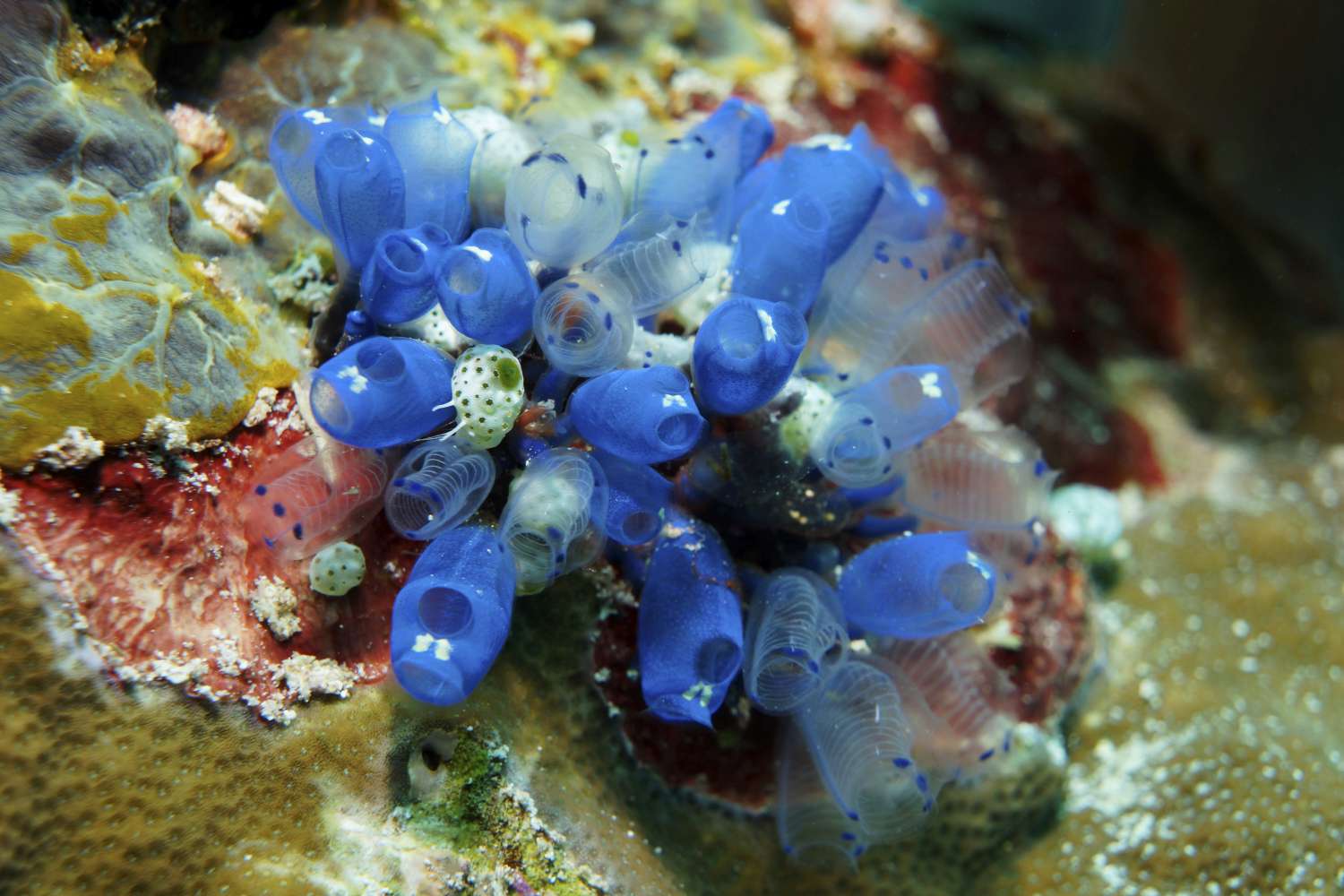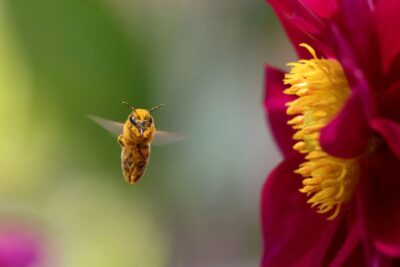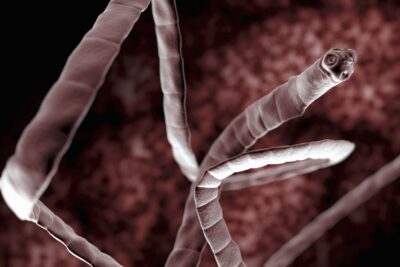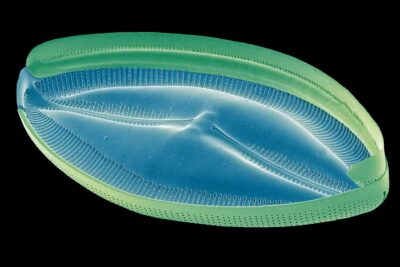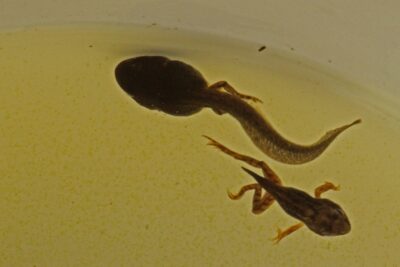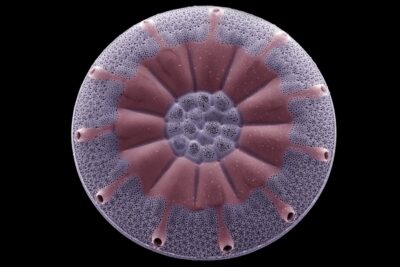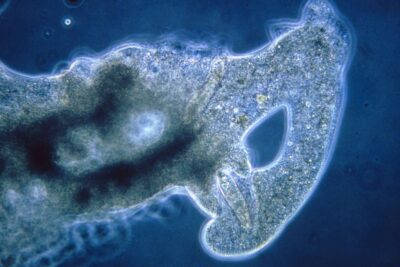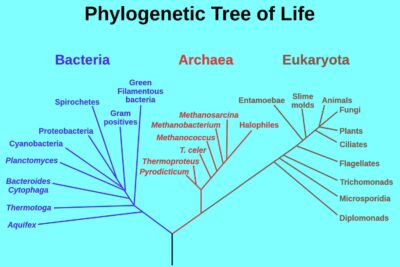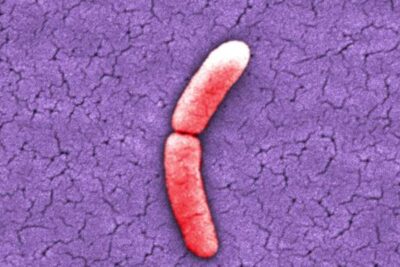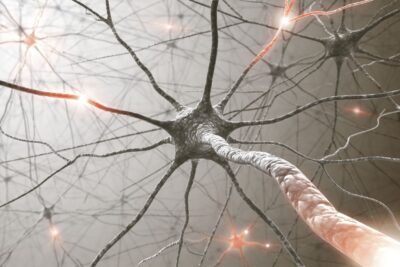
Invertebrate chordates are animals of the phylum Chordata that possess a notochord at some point in their development, but no vertebral column (backbone). A notochord is a cartilage-like rod that serves a supportive function by providing a site of attachment for muscles. In humans, who are vertebrate chordates, the notochord is replaced by a spinal column that serves to protect the spinal cord. This distinction is the main characteristic that separates invertebrate chordates from vertebrate chordates or animals with a backbone. The phylum Chordata is divided into three subphyla: Vertebrata, Tunicata, and Cephalochordata. Invertebrate chordates belong to both the Tunicata and Cephalochordata subphyla.
Key Takeaways
- All invertebrate chordates share four main characteristics: a notochord, a dorsal nerve tube, a post-anal tail, and pharyngeal gill slits. All of these characteristics are observed at some point in chordate development.
- Invertebrate chordates in the phylum Tunicata, also known as Urochordata, dwell in marine environments. They possess specialized external coverings for food filtration and are suspension feeders.
- There are three main classes in phylum Tunicata: Ascidiacea, Thaliacea, and Larvacea.
- The vast majority of tunicate species are ascidians. In their adult form, they are sessile. They stay in one location by anchoring to rocks or some other firm surface in the ocean.
Characteristics of Invertebrate Chordates
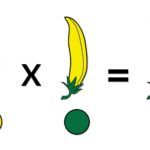 Ley de Mendel del Surtido Independiente
Ley de Mendel del Surtido IndependienteReinhard Dirscherl / Corbis Documentary / Getty Images
Invertebrate chordates are diverse but share many common characteristics. These organisms reside in marine environments living individually or in colonies. Invertebrate chordates feed on tiny organic matter, such as plankton, suspended in the water. Invertebrate chordates are coelomates or animals with a true body cavity. This fluid-filled cavity (coelom), located between the body wall and digestive tract, is what differentiates coelomates from acoelomates. Invertebrate chordates reproduce typically through sexual means, with some capable of asexual reproduction. There are four key characteristics that are common to chordates in all three subphyla. These traits are observed at some point during the development of the organisms.
Four Characteristics of Chordates
- All chordates have a notochord. The notochord extends from the animal's head to its tail, toward its dorsal (back) surface and dorsal to the digestive tract. It provides a semi-flexible structure for muscles to use for support as the animal moves.
- All chordates have a dorsal nerve tube. This hollow tube or nerve cord is dorsal to the notochord. In vertebrate chordates, the dorsal nerve tube develops into the central nervous system structures the brain and spinal cord. In invertebrate chordates, it is generally seen in the larval stage of development but not the adult stage.
- All chordates have a post-anal tail. This body extension goes beyond the end of the digestive tract and is seen only in the early developmental stages in some chordates.
- All chordates have pharyngeal gill slits. In invertebrate chordates, these structures are important for both feeding and respiration. Land vertebrates have gill structures in the early embryonic stages of development, which develop into other structures (ex. voice box) as the embryo matures.
All invertebrate chordates have an endosytle. This structure is found in the wall of the pharynx and produces mucus to assist in filtering food from the environment. In vertebrate chordates, the endosytle is thought to have adapted evolutionarily to form the thyroid.
Lectura relacionada: Estructura y Función de las Proteínas
Estructura y Función de las Proteínas
Tunicata: Ascidiacea
Jurgen Freund / Nature Picture Library / Getty Images
Lectura relacionada: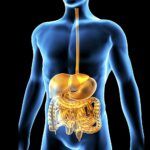 Guía de Estudio y Cuestionario sobre Sistemas de Órganos
Guía de Estudio y Cuestionario sobre Sistemas de Órganos
Invertebrate chordates of the phylum Tunicata, also called Urochordata, have between 2,000 and 3,000 species. They are suspension feeders dwelling in marine environments with specialized external coverings for food filtration. Tunicata organisms may live either alone or in colonies and are divided into three classes: Ascidiacea, Thaliacea, and Larvacea.
Ascidiacea
Ascidians make up most of the tunicate species. These animals are sessile as adults, meaning that they stay in one place by anchoring themselves to rocks or other firm underwater surfaces. The sac-like body of this tunicate is encased in a material composed of protein and a carbohydrate compound similar to cellulose. This casing is called a tunic and varies in thickness, toughness, and transparency between species. Within the tunic is the body wall, which has thick and thin epidermis layers. The thin outer layer secretes the compounds that become the tunic, while the thicker inner layer contains nerves, blood vessels, and muscles. Ascidians have a U-shaped body wall with two openings called siphons which take in water (inhalant siphon) and push out waste and water (exhalant siphon). Ascidians are also called sea squirts because of how they use their muscles to forcefully eject water through their siphon. Within the body wall is a large cavity or atrium containing a large pharynx. The pharynx is a muscular tube that leads to the gut. Tiny pores in the pharynx wall (pharyngeal gill slits) filter food, such as unicellular algae, from the water. The inner wall of the pharynx is covered with tiny hairs called cilia and a thin mucus lining produced by the endostyle. Both direct food toward the digestive tract. Water that is pulled in through the inhalant siphon passes through the pharynx to the atrium and is expelled through the exhalant siphon.
Some species of ascidians are solitary, while others live in colonies. The colonial species are arranged in groups and share an exhalant siphon. Although asexual reproduction can occur, the majority of ascidians have both male and female gonads and reproduce sexually. Fertilization occurs as male gametes (sperm) from one sea squirt are released into the water and travel until they unite with an egg cell within the body of another sea squirt. The resulting larvae share all of the common invertebrate chordate characteristics including a notochord, dorsal nerve cord, pharyngeal slits, endostyle, and a post-anal tail. They are similar to tadpoles in appearance, and unlike adults, the larvae are mobile and swim around until they find a firm surface on which to attach and grow. The larvae undergo metamorphosis and eventually lose their tail, notochord, and dorsal nerve cord.
Tunicata: Thaliacea
Justin Hart Marine Life Photography and Art / Moment / Getty Images
The Tunicata class Thaliacea includes doliolids, salps, and pyrosomes. Doliolids are very tiny animals measuring 1-2 cm in length with cylindrical bodies that resemble barrels. Circular bands of muscles in the body resemble the bands of a barrel, further contributing to its barrel-like appearance. Doliolids have two wide siphons, one located at the front end and the other at the back end. Water is propelled from one end of the animal to the other by beating cilia and contracting muscle bands. This activity drives the organism through the water in order to filter food through its pharyngeal gill slits. Doliolids reproduce both asexually and sexually through alternation of generations. In their life cycle, they alternate between a sexual generation that produces gametes for sexual reproduction and an asexual generation that reproduces by budding.
Salps are similar to doliolids with a barrel shape, jet propulsion, and filter-feeding capabilities. Salps have gelatinous bodies and live solitarily or in large colonies that can extend for several feet in length. Some salps are bioluminescent and glow as a means of communication. Like doliolids, salps alternate between sexual and asexual generations. Salps sometimes bloom in great numbers in response to phytoplankton blooms. Once the phytoplankton numbers can no longer support the large numbers of salps, salp numbers fall back down to normal ranges.
Like salps, pyrosomes exist in colonies formed from hundreds of individuals. Each individual is arranged within the tunic in a manner that gives the colony the appearance of a cone. Individual pyrosomes are called zooids and are barrel-shaped. They draw water in from the outside environment, filter the water of food through an internal branchial basket, and expel the water to the inside of the cone-shaped colony. Pyrosome colonies move along with the ocean currents but are capable of some propulsion movement due to cilia in their internal filtering mesh. Also like salps, pyrosomes exhibit alternation of generations and are bioluminescent.
Tunicata: Larvacea
Note at the bottom, the filter loaded with nutrient particles: phytoplankton algae or microorganisms.
Jean Lecomte / Biosphoto / Getty Images
Organisms in the class Larvacea, also known as Appendicularia, are unique from other species of the phylum Tunicata in that they retain their chordate features throughout adulthood. These filter feeders reside within an external gelatinous casing, called a house, that is secreted by the body. The house contains two internal openings near the head, an elaborate internal filtration system, and an external opening near the tail.
Larvaceans move forward through the open sea using their tails. Water is pulled in through the internal openings allowing for the filtration of tiny organisms, such as phytoplankton and bacteria, from the water. Should the filtration system become clogged, the animal can cast off the old house and secrete a new one. Larvaceans do so several times a day.
Unlike other Tunicata, larvaceans reproduce only by sexual reproduction. Most are hermaphrodites, meaning that they contain both male and female gonads. Fertilization occurs externally as sperm and eggs are broadcast into the open sea. Self-fertilization is prevented by alternating the release of sperm and eggs. Sperm is released first, followed by the release of the eggs, which results in the death of the parent.
Cephalochordata
Hans Hillewaert / Wikimedia Commons / CC BY-SA 4.0
Cephalochordates represent a small chordate subphylum with around 32 species. These tiny invertebrates resemble fish and can be found living in the sands in shallow tropical and temperate waters. Cephalochordates are commonly referred to as lancelets, which represent the most common cephalochordate species Branchiostoma lanceolatus. Unlike most Tunicata species, these animals retain the four main chordate characteristics as adults. They have a notochord, dorsal nerve cord, gill slits, and post-anal tail. The name cephalochordate is derived from the fact that the notochord extends well into the head.
Lancelets are filter feeders that bury their bodies in the ocean floor with their heads remaining above the sand. They filter food from the water as it passes through their open mouths. Like fish, lancelets have fins and blocks of muscles arranged in repeating segments along the body. These features allow for coordinated movement while swimming through the water to filter food or to escape predators. Lancelets reproduce sexually and have separate males (only male gonads) and females (only female gonads). Fertilization occurs externally as sperm and eggs are released into the open water. Once an egg is fertilized, it develops into a free-swimming larva feeding on plankton suspended in the water. Eventually, the larva goes through a metamorphosis and becomes an adult living mainly near the ocean floor.
Sources
- Ghiselin, Michael T. “Cephalochordate.” Encyclopædia Britannica, Encyclopædia Britannica, inc., 23 Oct. 2008.
- Jurd, R. D. Instant notes animal biology. Bios Scientific Publishers, 2004.
- Karleskint, George, et al. Introduction to marine biology. Cengage Learning, 2009.
- Staff, Dorling Kindersley Publishing. Animal: The Definitive Visual Guide, 3rd Edition. Dorling Kindersley Publishing, Incorporated, 2017.

